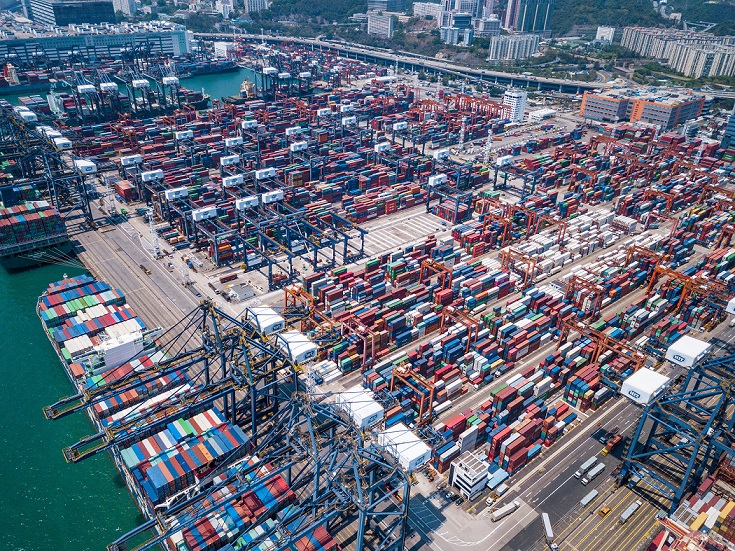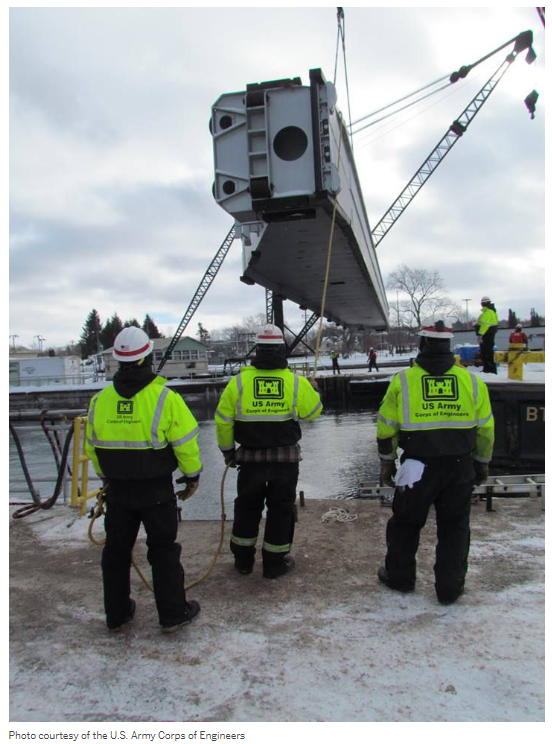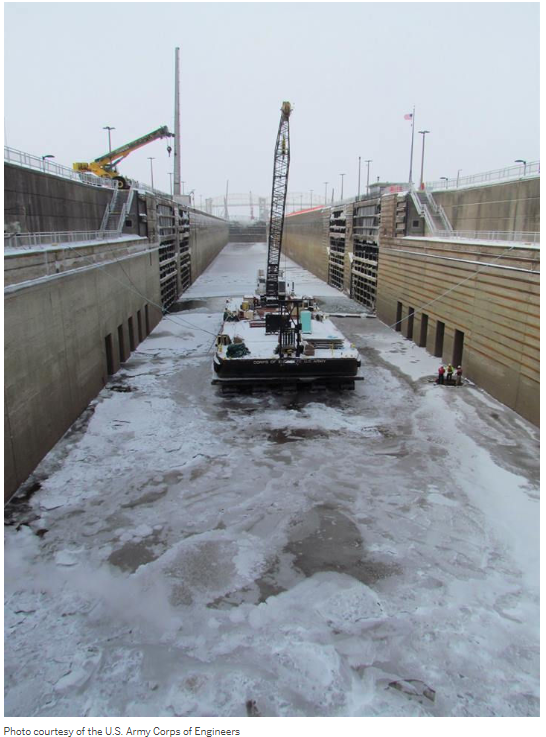Shipping and Logistics

Great Lakes Preparing for Shipping Season and Lock Construction
Written by Sandy Williams
March 3, 2019
The Soo Locks are scheduled to reopen on March 25 to begin the new shipping season on the Great Lakes. The last vessel through the locks was the Canadian bulk-carrier Manitoulin headed for Essar Steel on Jan. 15. The locks are currently closed for maintenance prior to the start of the 2019-20 season.
During the maintenance phase the two operating locks of the Soo complex, the Poe and MacArthur, are drained of water so that inspection and repairs can be performed. In the picture below, steel stop logs are inserted into the upper end of the Poe Lock to create a temporary dam spanning the lock chamber. Each log weighs about 49 tons and is stacked on top of another.
Divers open valves at the bottom of the lock and the water is pumped from the lock. The Poe and MacArthur contain a combined 73.3 million gallons of water. Draining the water from the Poe took 17 hours.
While maintenance proceeds at the Soo Locks, lake vessels in lay-up are preparing to resume work once the shipping lanes are open and ice coverage dissipates. Ice as of March 1 covered 74.2 percent of the Great Lakes, as compared to 34.2 percent at this time last year. More than three-quarters of Lake Superior, home to the Minnesota and Michigan iron ore ports, remains frozen. Once the season begins, the U.S. and Canadian Coast Guard Cutters will move into action freeing remaining ice from the navigation channels.
The Lake Carriers Association says heavy ice delayed vessels during the first two months of the 2018 season, causing trade to be off 16 percent by the end of April compared to 2017 shipping levels. Ice persisted on the lakes through May last year.
U.S.-flag freighters moved nearly 84 million tons of cargo in 2018. Of that cargo, 45.8 million tons was iron ore.
Work on New Lock to Begin
The Soo Locks will be a site of welcome construction activity this year. The U.S. Army Corps of Engineers has allocated $32 million to begin the design and construction of a new supersized lock that will accommodate the largest Great Lakes freighters. Currently, only two locks at the Sault Ste. Marie complex are operational, with only the Poe lock capable of handling the large lakers that carry iron ore and coal to U.S. steel mills. The new lock will be a twin brother to the Poe, 110 feet wide with a depth of 32 feet, and able to handle vessels of up to 1,200 feet in length.
The project has been delayed since 1986, but was included in the Corps of Engineers work plan for FY 2019. Federal funding for the project was authorized under a water infrastructure bill signed by the president in September.
The State of Michigan will offer an additional $52 million to the project, which is estimated to reduce the construction time by one year and save taxpayers about $30 million on the overall cost of $922 million.
The project will take seven to 10 years to complete and will be augmented by additional funding through annual appropriations.
“The new Soo Lock would eliminate the single point of failure in our nation’s iron ore supply chain,” said Commander Greg Turner of the U.S. Army Corps of Engineers Detroit District at a Sault Ste Marie City Commission meeting last week.
A study done by the Department of Homeland Security in 2017 highlighted the economic crisis that would occur should the Poe lock suffer an unexpected closure during the shipping season. “Depending on what time of year the closure occurred, approximately 75 percent of the U.S. integrated steel production would cease within 2-6 weeks after the closure of the Poe Lock,” states the report. “Approximately 80 percent of iron ore mining operations, and nearly 100 percent of the North American appliances, automobile, construction equipment, farm equipment, mining equipment, and railcar production would shut down.”
The stress on the manufacturing sector would lead to a severe recession that could impact 11 million jobs in the U.S. and millions more in Mexico and Canada.
Sen. Debbie Stabenow (D-Lansing) expressed concern that President Trump’s declaration of a national emergency on the southern border might cause the Soo Lock funding to be reallocated from the Army Corps of Engineers to build the border wall.
The Restrictions Against Illegitimate Declarations for Emergency Re-appropriations (RAIDER) Act of 2019, sponsored by 15 Democrats, including Stabenow, was introduced to the Senate on Feb. 4 to prevent funding designated for the Army Corps of Engineers and military construction and disaster response being used to build the wall.
Stabenow’s Michigan colleague Rep. John Moolenarr (R-Midland) says that the language protecting the funding is already included in the original appropriations bill.
The funding for the Corps of Engineers and the Soo Locks is authorized in the Energy and Water, Legislative Branch, and Military Construction and Veterans Affairs Appropriations Act, 2019. Moolenarr noted that under the act, “the Secretary [of the Army for Civil Works] may not deviate from the new starts proposed in the work plan once the plan has been submitted to the Committees on Appropriations of both Houses of Congress.”
The act further states that funds may not be reprogrammed for a different purpose “unless prior approval is received from the House and Senate Committees on Appropriations.”
Whether passage of the RAIDER Act will be necessary may depend on other actions of Congress. The House passed a resolution on Tuesday to terminate the president’s national emergency and the Senate will vote on it by March 18. Whether there will be enough votes from Republicans to pass the resolution in the Senate is uncertain, or if a majority can be mustered to override a veto by Trump. Court action is also in progress regarding the legality of the president’s declaration and his authority to seize funds that have been designated for other purposes.
The need for an additional Poe-sized lock at Sault Ste. Marie is clear to those who navigate the Great Lakes and those who use the products delivered by the massive lake vessels.
“The Soo Locks are essential to our economy and national security,” said Michigan Gov. Rick Snyder. “The time is long overdue for construction to begin on the new lock.”

Sandy Williams
Read more from Sandy WilliamsLatest in Shipping and Logistics

US Great Lakes iron ore cargoes down notably through May
The Lake Carriers' Association reported a considerable decline in monthly iron ore shipments from US ports on the Great Lakes.

Wittbecker: West Coast port congestion
What's going on in West Coast ports?

Wittbecker: Mexico invests in port capacity despite US tariff troubles
The Mexican government aims to transform Manzanillo into the largest seaport in Latin America, capable of processing some 10 million TEU (20-foot equivalent units) per year by 2030. It is already Mexico's largest port and the third largest in Latin America, handling nearly 4 million 20-foot containers in 2024.

Wittbecker on Aluminum: When do the tariffs reach Main Street?
Containers sailing from China in April are down 15%-20% and Hapag Lloyd says their future bookings transpacific are down 30%.

Wittbecker on Aluminum: US-China trade war clobbers cross-Pacific trade
Container shipping lines have sharply increased blank sailings on Transpacific routes in response to escalating trade tensions between the US and China.


